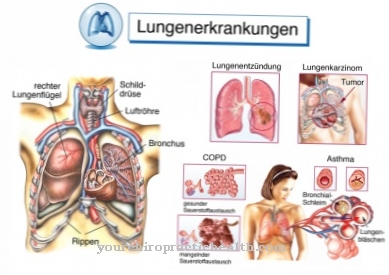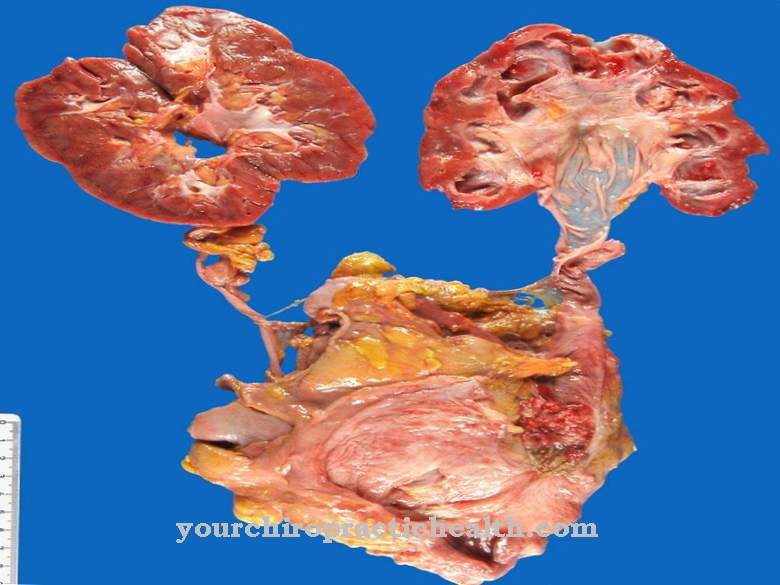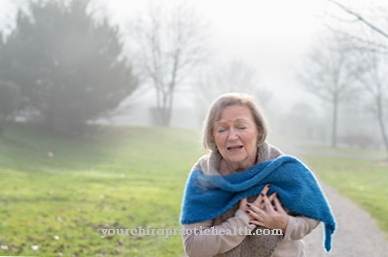The Polyarthrosis, a special form of osteoarthritis, is multiple cartilage damage and the most common joint disease worldwide. Around 5 million people are affected in Germany.
What is polyarthrosis?

The name is made up of the Greek words for "many" (-poly) and "joint" (athron). It defines a multiple breakdown of joint substance that exceeds age-related joint wear. At least three different types of joint must be affected, otherwise it is arthrosis.
A common example is finger joint arthrosis. The symptoms are pain in the affected joints. A distinction must be made here between pain of the non-inflammatory type and pain of the inflammatory type. The non-inflammatory pain occurs when the affected areas are stressed and normally disappears during periods of rest.
The opposite is true for pain of the inflammatory type. They gain weight when the joint is at rest. This case is known as activated polyarthrosis. Visually, deformations and inflammatory swellings determine the symptomatic appearance of the disease. An increase in synovial fluid is also possible.
The result is restricted mobility, which can lead to an inability to function. Morning stiffness can also occur, but if it occurs more intensively, this indicates a rheumatic disease.
causes
The reasons for the development of polyarthrosis are largely unclear. It is controversial whether their causes depend on increased stress on the articular cartilage. It is possible that injury-related and congenital misalignments of the joints, called dysplasias, can promote the development of polyarthrosis.
They prevent an optimal distribution of the weight when moving, because the area intended for it is minimized. The load must focus on a reduced point of contact. At this point, it accelerates cartilage wear.
Other reasons for unnaturally high stress on the joints can be overweight and constant, constant strain on the affected body parts. A genetically determined susceptibility, however, is considered proven. Rheumatic diseases, gout, endocrine gland diseases, diabetes mellitus and hemophilia are suspected to be further favorable factors.
Symptoms, ailments & signs
The first signs of polyarthrosis usually appear on the finger joints. Both the end and middle joints and the thumb saddle joints are affected. At first they only hurt when you move unfamiliar, later they hurt with every movement and finally the rest position is painful too.
Patients often complain that their fingers crack or that rubbing noises can be heard. If the joints are overworked for a long period of time, they can become inflamed. Then the corresponding region is reddened, feels warm, hurts and is swollen. However, polyarthrosis can also occur completely without these signs.
Often the fingers become stiff and their mobility is clearly restricted. Joint effusion is possible in the further course. The symptoms often spread to the muscles and tendons. It is typical of polyarthrosis that the symptoms also show up in many other joints.
The toe joints can be affected, but also large joints such as the hip and knee joints. More rarely, the disease affects the shoulder joints and the joints between the collarbone and sternum. In exceptional cases, the small vertebral joints can also be involved. The basal joints of the fingers and toes, the wrists and elbow joints and the ankle joints are usually almost never affected in this disease.
Diagnosis & course
For a diagnosis of polyarthrosis, the affected parts of the body are checked for typical swellings. Then an image of the joints is taken with the help of an imaging procedure. X-rays show a narrowing of the joint space and other changes that indicate overloading.
These include small cysts that arise from the increased accumulation of synovial fluid, bone compression and cracks. The cartilage wear cannot yet be traced here. Magnetic resonance imaging must be carried out for this. This makes arthritic changes visible at an early stage.
A joint endoscopy, known as arthroscopy, can alternatively be used to view the joint. Its advantage is that it also enables the damage found to be treated. Activated osteoarthritis is fundamentally more difficult to diagnose than non-inflammatory osteoarthritis because it is very similar to other clinical pictures.
In the course of the disease, the development of a chronic rheumatic expression, rheumatoid arthritis, is possible and should be prevented at all costs.
Complications
Due to polyarthrosis, patients suffer from various ailments in the joints. This usually results in irreversible damage to the cartilage.Furthermore, polyarthrosis leads to severe pain in the patient's joints. This results in various restrictions in everyday life and also movement restrictions in the patient.
As a result, the quality of life is considerably reduced and those affected are then often dependent on the help of other people. Particularly with high loads, severe pain occurs. Polyarthrosis can also lead to water retention in various parts of the body. The joints themselves often crack and can also be swollen. In many cases, polyarthrosis also has a very negative effect on the patient's psyche, which can lead to depression or other psychological complaints.
Because of the constant pain, those affected are often irritated. As a rule, polyarthrosis is treated with the help of medication. There are no complications. However, the person concerned is dependent on a healthy lifestyle in order to avoid further complaints. Life expectancy is usually not influenced by polyarthrosis.
When should you go to the doctor?
Problems or restrictions in joint activity should be clarified with a doctor. If the symptoms occur in direct connection with physical overload or heavy strain on the musculoskeletal system, the person affected normally needs sufficient rest and rest. After a good night's sleep or some period of regeneration, the symptoms will ease until a full recovery occurs.
A doctor is not needed in these cases, as the condition is not a concern. If the irregularities persist or if they increase in intensity, a visit to a doctor is advisable. In the case of morning stiffness, repeated disorders of the movement sequences and pain in the joints, an examination is required to clarify the cause.
If normal sporting activities can no longer be carried out or if there are impairments in coping with everyday life, it is advisable to consult a doctor. Pain medication should generally only be taken in consultation with the attending physician in order to avoid further deterioration in health due to side effects.
If, in addition to the physical complaints, mental or emotional abnormalities occur, the changes must be discussed with a doctor. A doctor should be consulted in the case of a depressed mood or a tendency to depressive phases. A withdrawal behavior, irritability or mood swings are further indications of a health impairment.
Treatment & Therapy
Polyarthrosis is incurable. The cartilage abrasion cannot be reversed. Therefore the symptoms are treated. Anti-inflammatory pain relievers such as ibuprofen or diclofenac are prescribed for the pain. An ointment containing cortisone can also provide short-term relief.
If the pain is severe, a local anesthetic or a cortisone preparation can be injected. In addition, physical therapy measures can be used to alleviate the symptoms. Heat or cold treatments, and contracture treatments, in which the affected joints are stimulated by pulling, can be helpful. Activation through gentle movements that are carried out in occupational therapy or with simple manual activities has a mobilizing effect.
Special splints can stabilize the joints and compensate for possible misalignments. A direct injection of hyaluronic acid into the affected joint has a pain relieving effect. Due to its composition, it improves the lubricity of the fluid in the joint and causes a short-term regeneration phase. In addition to the symptomatic treatment options, the factors favoring polyarthrosis should be reduced or avoided.
These include weight reduction and relief of the affected body parts. With sporting activities that are gentle on the joints, the muscles can also be strengthened, which is also beneficial for overall physical well-being. Sports that put a lot of stress on the joints should be avoided.
prevention
Exercising gently and regularly can help prevent arthritic disease. On the one hand, this strengthens the muscles. On the other hand, the joints are mobilized, which has a supporting effect on the function of the bile and regulates the metabolism in the joint.
A good blood supply to the joints should be ensured, e.g. through regular heat or cold applications. Risk factors such as being overweight and overworking should be minimized. In addition, care must be taken to avoid accidents that can lead to joint injuries.
Aftercare
In most cases, those affected with polyarthrosis have very few or no special follow-up measures available. First and foremost, a doctor should be consulted very early and, above all, very quickly so that there are no further complications or other complaints for the person concerned. Self-healing cannot occur with polyarthrosis.
Treatment itself is usually based on taking various medications. Those affected should ensure the correct dosage and regular intake of the medication in order to relieve the symptoms over the long term. Physiotherapy measures can also be useful.
Many of the exercises from such therapies can also be performed at home, which speeds healing in most cases. In general, a healthy lifestyle with a healthy diet also has a very positive effect on the further course of the disease. Those affected should also reduce their weight to alleviate the symptoms of polyarthrosis.
You can do that yourself
Polyarthrosis is incurable, but the course of the disease can be positively influenced by a few simple measures. Regular exercise counteracts the breakdown of cartilage, and strong muscles also stabilize the joints. Gentle sports such as cycling, Nordic walking or swimming are well suited, and runners don't have to do without their sport: They should, however, wear high-quality running shoes with good cushioning, run little uphill and downhill and, if possible, prefer forest paths to paved roads.
Comfortable shoes are also preferable to high-heeled shoes in everyday life; in advanced disease, insoles or height adjustment can bring relief. Standing for long periods of time and carrying heavy loads put a strain on the joints and should be avoided as far as possible. Eating a healthy diet helps reduce excess weight and can reduce inflammation in the body. A low-fat and vitamin-rich diet has a beneficial effect; animal fats in particular should rarely be on the menu. Leek, onion and garlic as well as many spices and herbs have anti-inflammatory effects, fruit, vegetables, salads, potatoes, brown rice and skimmed milk products contribute to an adequate supply of vitamins and trace elements.
Mackerel and sardines, like cold-pressed oils, are rich in valuable omega-3 fatty acids, which protect blood vessels and can inhibit joint inflammation. Sugar, saturated and hydrogenated fats as well as citrus fruits, coffee, alcohol and black tea should only be consumed in moderation.

.jpg)




.jpg)






.jpg)

.jpg)
.jpg)











.jpg)